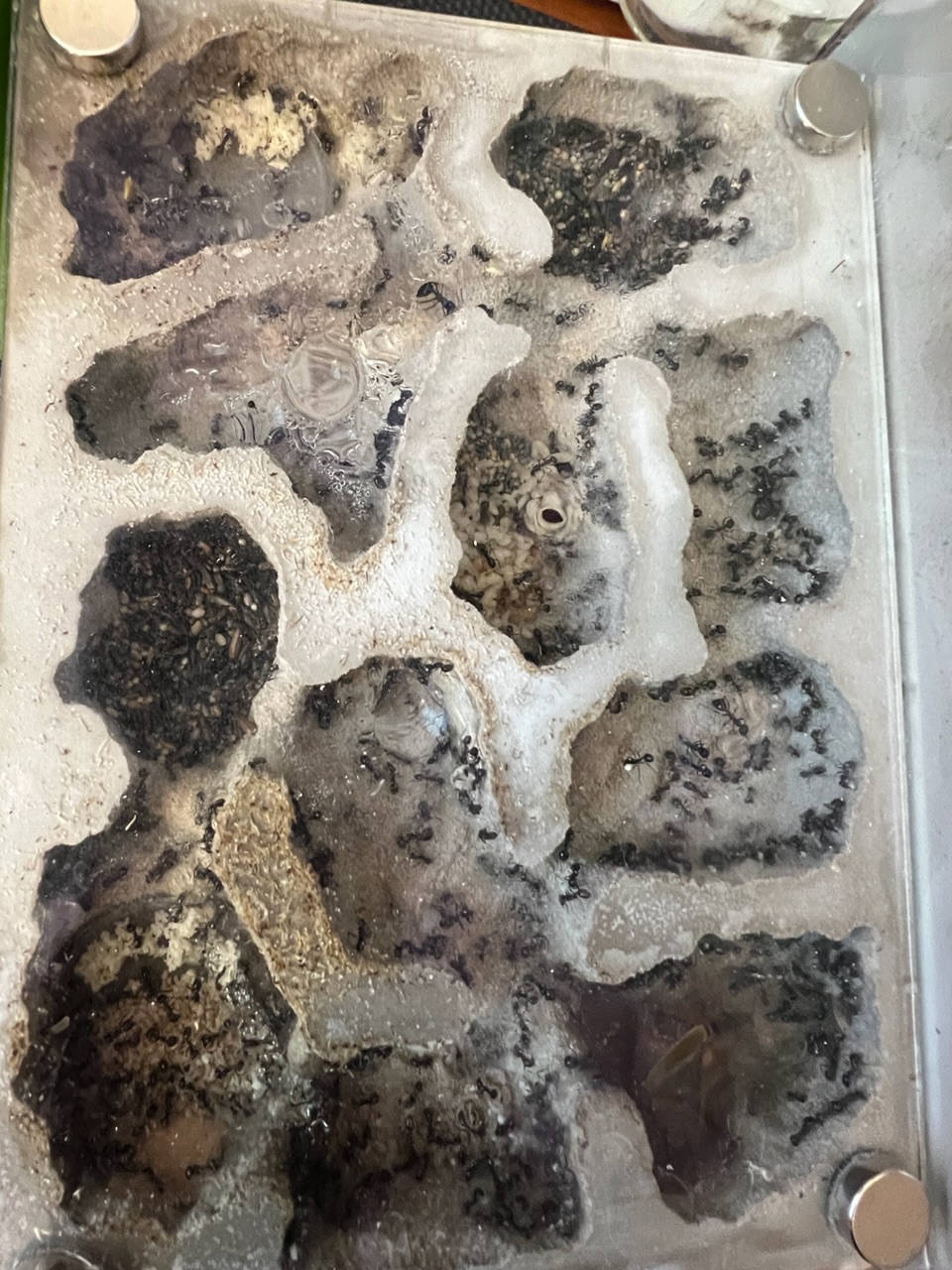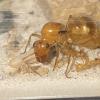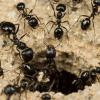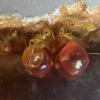- Formiculture.com
- Forums
- Gallery
- Members
- Member Map
- Chat

OhNoNotAgain's Veromessor pergandei (caresheet page 7), V. andrei, Novomessor cockerelli
Started By
OhNoNotAgain
, Jan 15 2020 2:33 PM
veromessor pergandei veromessor pergandei harvester ant harvester ants beginner novomessor cockerelli
130 replies to this topic
#121
 Offline
-
Posted June 6 2023 - 8:01 PM
Offline
-
Posted June 6 2023 - 8:01 PM
Annnnnd I neglect them a few days and discover the smaller colony was dying of thirst. You know when even the queen is in the corner of the outworld trying to find water, on top of a pile of corpses, it’s bad. Now I’ve watered them so much I can’t see how they are through the condensation. Good part is the pupae seem to still be alive at least. I herded the queen back to the nest and she was last seen drinking from the floor….
Formiculture Journals::
Veromessor pergandei, andrei; Novomessor cockerelli
Camponotus fragilis; also separate journal: Camponotus sansabeanus (inactive), vicinus, laevigatus/quercicola
Liometopum occidentale; Prenolepis imparis; Myrmecocystus mexicanus (inactive)
Pogonomyrmex subnitidus and californicus (inactive)
Tetramorium sp.
Termites: Zootermopsis angusticollis
Isopods: A. gestroi, granulatum, kluugi, maculatum, vulgare; C. murina; P. hoffmannseggi, P. haasi, P. ornatus; V. parvus
Spoods: Phidippus sp.
#122
 Offline
-
Posted July 2 2023 - 7:29 PM
Offline
-
Posted July 2 2023 - 7:29 PM
I wrote up a caresheet that I've sent in for consideration. In case it doesn't make the cut, I post it here. Forgot to mention in it: They acclimate to being in light. My Vero nests are not covered by red film or light blockers at all.
Scientific Name: Veromessor pergandei (or Messor pergandei in older literature)
Common Name: black harvester ant, desert harvester ant
Distribution: Primarily desert regions of North America, such as in southern California, Nevada, Arizona, and Mexico. Does not usually extend into Utah or New Mexico. “Mohave desert, Sonoran desert, Baja California desert, Gulf of California xeric scrub, and California coastal sage and chaparral ecoregions” (Johnson et al., 2022; via AntWiki)
Queen size: 10mm.
Worker size: Polymorphic, 4-8mm.
Natural Habitat: Desert
Circadian Activity: Diurnal in winter; crepuscular (dawn/dusk foraging) in summer.
Mating Flight: February, March, April. Dependent on photoperiod, not rainfall. Theory is that V. pergandei queens cannot tolerate hot summer temperatures, so they must fly in the cooler months.
Queen Founding Method: Fully claustral, but it doesn’t hurt to provide some seeds or protein to founding queens. Their relatives V. andrei are semi-claustral.
Monogyne or Polygyne: Can be monogyne (only one queen), pleo (delayed monogyne), or polygyne (multiple queens). This varies by location. Primarily polygynous V. pergandei apparently tend to occur at the border between California, Nevada, and Arizona. Other California V. pergandei tend to be monogyne, and those deeper in Arizona are pleo.
Average time from egg to worker: -
Recommended Temperature: Summer temperature: 85-89 F (29.4 C – 32 C). Temps lower than roughly 85 F the queen may not lay eggs. Do not set temps too high; queens do not have extreme heat tolerance and are known to die at 107 F (42C). Provide a heat gradient. Winter temperature: roughly 70 (21.1 C) is fine.
Recommended Humidity: Provide humidity gradient. Veromessor pergandei like humid areas of their nest for putting their larvae, but prefer to store seeds in dry sections.
Preferred Foods: Seeds: dandelion, poppy, amaranth, quinoa, Kentucky blue grass, other seeds – choose organic where possible. They can get excited about sunflower seeds but may not be able to open them. Insects: fruit flies, crickets, roaches, mealworms, etc. They do not need sugar water. Supposedly they do not have a social stomach.
Hibernation Details: Active all year, but let the queen rest from egg-laying over the winter. Room temperature (e.g. 70 F/21 C) is fine. Provide at least three months’ of rest, with occasional seed (not as necessary if they have seed stockpiled). Always provide fresh water. As winter ends, gradually increase temps, gradually start offering new seed, once a week offer small amounts of insect protein (not mandatory, but beneficial in small quantities), and by late spring or early summer allow them to have full summer temperature. This will allow them to begin producing brood. This is also when their water will evaporate the fastest and the ants will be the thirstiest, so check the water frequently. If you are delayed in providing heat (e.g., one year I didn’t raise the temperature high enough until late summer), at least give them heat long enough for them to raise up a new generation of workers to replenish those that will soon die of old age. In fall, gradually lower temperatures and reduce food, always making sure to keep the fresh water supply available.
Escape Barrier Methods: Fluon, or food-grade mineral oil (very thinly applied to the outworld, but may still kill some workers; do not use mineral oil with founding colonies with only a few workers)
Difficulty rating: Easy.
Bite and/or Sting rating: No sting; harmless bite.
Special Care or Interesting Notes: Veromessor pergandei is a terrific beginner ant, easy to keep, not dangerous, active all year, polymorphic (eventually), and easy to feed because they do not depend on frequent insect protein (though they do benefit from it). They also do not need sugar water!
They DO need water, all the time.
Read through the notes on the temperature changes from winter to summer and back. Unlike many ants, they do not need to go into a wine fridge and can be observed in the winter. But they do want something of a vacation from baby making.
Veromessor pergandei have something of a reputation for being boring, but they can be exciting in some regards. Yes, they grow larger workers (sometimes called majors). And they also grow lots of workers. For example, they can theoretically exceed 50,000 workers, they can theoretically produce upwards of 650 new workers per DAY, and they like to forage in large columns. This means that feeding time can trigger a mass foraging column, and the phototropic ants will try to march en masse toward the nearest light source and escape from the outworld. Their style of foraging also means they are not the favorite prey of the desert horned lizard, since the lizard is likely to get mobbed by angry ants. Speaking of angry ants, Veromessor pergandei has been observed to dismantle spider webs to rescue nestmates, an apparently unusual behavior among ants. (However, it should be noted that only the largest workers do this sort of rescue behavior.)
You are NOT obligated to provide so much food they produce 650 new workers a day, but you do need to provide enough food they replenish the workers that die of old age.
Individuals have been observed to chew persistently on nest walls, so suggest avoiding softer nest materials and sticking with hard materials.
Speaking of escape, Veromessor pergandei are fairly small ants, and are able to slip through cracks easily. They are, thankfully, larger than Tetramorium, and a healthy, established colony should be producing a good number of larger workers.
Additional Links:
https://www.antwiki....essor_pergandei
http://treatment.pla...FC5FE1E5DECFBBD
https://academic.oup...7/1/271/1744921 (Mono, pleo, or poly discussion)
Edited by OhNoNotAgain, July 2 2023 - 7:37 PM.
- 100lols and raydr like this
Formiculture Journals::
Veromessor pergandei, andrei; Novomessor cockerelli
Camponotus fragilis; also separate journal: Camponotus sansabeanus (inactive), vicinus, laevigatus/quercicola
Liometopum occidentale; Prenolepis imparis; Myrmecocystus mexicanus (inactive)
Pogonomyrmex subnitidus and californicus (inactive)
Tetramorium sp.
Termites: Zootermopsis angusticollis
Isopods: A. gestroi, granulatum, kluugi, maculatum, vulgare; C. murina; P. hoffmannseggi, P. haasi, P. ornatus; V. parvus
Spoods: Phidippus sp.
#123
 Offline
-
Posted July 3 2023 - 5:24 PM
Offline
-
Posted July 3 2023 - 5:24 PM

Veromessor pergandei started 2019, summer 2023. Three brood chambers in this Labyrinth.
Brood in top left, bottom left, and older brood in middle.
Temp gradient is 89F on left (heat mat thermostat) and close to 80F on right (room temperature).
There are not many workers this year as last year I started heating late.
Edited by OhNoNotAgain, July 3 2023 - 5:28 PM.
- 100lols and raydr like this
Formiculture Journals::
Veromessor pergandei, andrei; Novomessor cockerelli
Camponotus fragilis; also separate journal: Camponotus sansabeanus (inactive), vicinus, laevigatus/quercicola
Liometopum occidentale; Prenolepis imparis; Myrmecocystus mexicanus (inactive)
Pogonomyrmex subnitidus and californicus (inactive)
Tetramorium sp.
Termites: Zootermopsis angusticollis
Isopods: A. gestroi, granulatum, kluugi, maculatum, vulgare; C. murina; P. hoffmannseggi, P. haasi, P. ornatus; V. parvus
Spoods: Phidippus sp.
#124
 Offline
-
Posted October 30 2023 - 9:17 AM
Offline
-
Posted October 30 2023 - 9:17 AM
I turned the Novomessor story into a video.
Edited by OhNoNotAgain, October 30 2023 - 9:23 AM.
- Full_Frontal_Yeti, 100lols and raydr like this
Formiculture Journals::
Veromessor pergandei, andrei; Novomessor cockerelli
Camponotus fragilis; also separate journal: Camponotus sansabeanus (inactive), vicinus, laevigatus/quercicola
Liometopum occidentale; Prenolepis imparis; Myrmecocystus mexicanus (inactive)
Pogonomyrmex subnitidus and californicus (inactive)
Tetramorium sp.
Termites: Zootermopsis angusticollis
Isopods: A. gestroi, granulatum, kluugi, maculatum, vulgare; C. murina; P. hoffmannseggi, P. haasi, P. ornatus; V. parvus
Spoods: Phidippus sp.
#125
 Offline
-
Posted October 31 2023 - 11:13 PM
Offline
-
Posted October 31 2023 - 11:13 PM
Nice video! Awesome journal. I have some reading to do 
- OhNoNotAgain likes this
#126
 Offline
-
Posted November 5 2023 - 9:39 AM
Offline
-
Posted November 5 2023 - 9:39 AM
I remember following this in the summer and then I comepletely forgot about it. can't wait for next updates
- OhNoNotAgain likes this
#127
 Offline
-
Posted November 5 2023 - 2:58 PM
Offline
-
Posted November 5 2023 - 2:58 PM
I remember following this in the summer and then I comepletely forgot about it. can't wait for next updates
Haha, thanks. I haven't updated much of the year - and pre-Halloween I was busy with my third bug fiction book - but I'm glad to be updating again. I WILL say there was an accident involving trying to pick up some tweezers stuck to the magnets of the glass covering the nest of my Veromessor andrei.... ![]() That led to the two YouTube videos about rescuing ants (in the main forum).
That led to the two YouTube videos about rescuing ants (in the main forum). ![]() The electronic aspirator really is very, very useful. I spent some hours freaking out about if I lost the queen or not, but I did see her briefly hanging out in a jar in the outworld.
The electronic aspirator really is very, very useful. I spent some hours freaking out about if I lost the queen or not, but I did see her briefly hanging out in a jar in the outworld.
ETA: If the nest glass is accidentally removed, it's important not to follow the first instinct of putting it back on immediately because of risk of queen squish, but that also means you'll have a massive growing pool of panicked ants on the table. The GOOD news is they tend to be nursery workers and most won't run off exploring. That's also when the electric aspirator comes in really handy, plus having a spare large bin to put the open formicarium into. Alsooooo, it's sad but true that in a real emergency, there's no time to take footage....
Edited by OhNoNotAgain, November 5 2023 - 3:03 PM.
- 100lols likes this
Formiculture Journals::
Veromessor pergandei, andrei; Novomessor cockerelli
Camponotus fragilis; also separate journal: Camponotus sansabeanus (inactive), vicinus, laevigatus/quercicola
Liometopum occidentale; Prenolepis imparis; Myrmecocystus mexicanus (inactive)
Pogonomyrmex subnitidus and californicus (inactive)
Tetramorium sp.
Termites: Zootermopsis angusticollis
Isopods: A. gestroi, granulatum, kluugi, maculatum, vulgare; C. murina; P. hoffmannseggi, P. haasi, P. ornatus; V. parvus
Spoods: Phidippus sp.
#128
 Offline
-
Posted November 6 2023 - 9:09 AM
Offline
-
Posted November 6 2023 - 9:09 AM
That’s some good advice! Mature colony updates are always nice to read.
I take a secondary safety step, following after nurbs, and tape the glass down even with magnets.
I take a secondary safety step, following after nurbs, and tape the glass down even with magnets.
- OhNoNotAgain likes this
#129
 Offline
-
Posted February 29 2024 - 8:08 PM
Offline
-
Posted February 29 2024 - 8:08 PM
Update?
- OhNoNotAgain likes this
Currently keeping: 2 C.vicinus colonies.2 C.sansabeanus. 1 C.leavissimus. 2 C.Ca02. 1 V.pergandei. 4 T.immigrans.1 F.pacifica. 1 C.hyatti
1 M.ergatognya
Trying to get my hands on :C.modoc,A.vercicolor, and Any Honeypots
#130
 Offline
-
Posted August 11 2024 - 9:19 PM
Offline
-
Posted August 11 2024 - 9:19 PM
Updates:
Veromessor pergandei 1: Still going!
Veromessor pergandei 2: Still going! I have some videos on YouTube.
Veromessor andrei: Still going!
Novomessor cockerelli: Still going! (Remember this is the second colony with the bittersweet story, YouTube video a few entries above)
I have recently (in the last few weeks) acquired a couple more Veromessor andrei (one to give away to someone who requested an "easy" ant colony, others were as spares) plus one viable Veromessor stoddardi and one likely dud with a missing antenna.
Here's a video of the newly arrived Veromessor andrei.
Formiculture Journals::
Veromessor pergandei, andrei; Novomessor cockerelli
Camponotus fragilis; also separate journal: Camponotus sansabeanus (inactive), vicinus, laevigatus/quercicola
Liometopum occidentale; Prenolepis imparis; Myrmecocystus mexicanus (inactive)
Pogonomyrmex subnitidus and californicus (inactive)
Tetramorium sp.
Termites: Zootermopsis angusticollis
Isopods: A. gestroi, granulatum, kluugi, maculatum, vulgare; C. murina; P. hoffmannseggi, P. haasi, P. ornatus; V. parvus
Spoods: Phidippus sp.
#131
 Offline
-
Posted August 11 2024 - 9:21 PM
Offline
-
Posted August 11 2024 - 9:21 PM
OH I should've posted this, too.
A dandelion dismantling race between two Veromessor species. From back in February 2024.
Edited by OhNoNotAgain, August 11 2024 - 9:22 PM.
Formiculture Journals::
Veromessor pergandei, andrei; Novomessor cockerelli
Camponotus fragilis; also separate journal: Camponotus sansabeanus (inactive), vicinus, laevigatus/quercicola
Liometopum occidentale; Prenolepis imparis; Myrmecocystus mexicanus (inactive)
Pogonomyrmex subnitidus and californicus (inactive)
Tetramorium sp.
Termites: Zootermopsis angusticollis
Isopods: A. gestroi, granulatum, kluugi, maculatum, vulgare; C. murina; P. hoffmannseggi, P. haasi, P. ornatus; V. parvus
Spoods: Phidippus sp.
Also tagged with one or more of these keywords: veromessor pergandei, veromessor, pergandei, harvester ant, harvester ants, beginner, novomessor, cockerelli
0 user(s) are reading this topic
0 members, 0 guests, 0 anonymous users



















![Ants_Dakota's Pogonomyrmex occidentalis Journal[Discontinued] - last post by Ants_Dakota](https://www.formiculture.com/uploads/profile/photo-thumb-4828.jpg?_r=1723914036)


